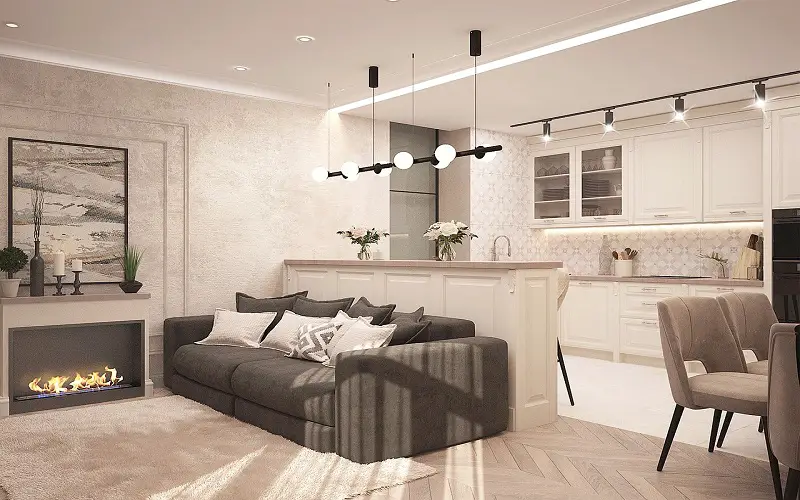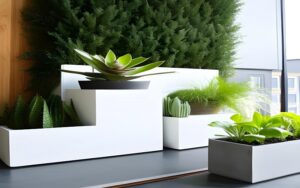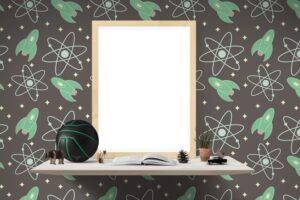In the world of interior design, understanding the dynamics of warm and cool colors is crucial for creating visually appealing and harmonious spaces.
Warm colors, such as reds and oranges, exude energy and vibrancy, while cool colors like blues and greens bring a sense of calm and tranquility.
This article explores how to effectively use warm and cool colors as interior design tools, considering their unique characteristics and the desired atmosphere they can bring to any space.
The Basics of Warm and Cool Colors
Warm and cool colors are fundamental elements in the world of color theory.
Warm colors, such as reds, oranges, beiges, and yellows, create a sense of energy and positivity in a space.
On the other hand, cool colors, including grays, greens, and blues, inspire a feeling of calm and relaxation.
It is important to note that the traditional classification of warm and cool colors is not rigidly defined, as each hue on the color wheel is multidimensional and can have different tones.
Additionally, the choice of warm or cool colors depends on factors such as color temperature, saturation, light conditions, and personal preferences.
How to Incorporate Warm and Cool Colors in Interior Design
When incorporating warm and cool colors in interior design, it is essential to consider the desired atmosphere and balance between the two.
Warm colors such as reds, oranges, and yellows can create a welcoming and energetic ambiance, making them suitable for public rooms like living and dining spaces.
On the other hand, cool colors like blues and greens can inspire a sense of calm and relaxation, making them great for private spaces like bedrooms and libraries.
Color temperature, saturation, light conditions, and personal preferences all play a role in determining which colors to use.
It is important to remember that warm and cool colors can be combined to create a balanced and harmonious space.
The Impact of Colors on Mood
To fully comprehend the impact of colors on mood, it is essential to analyze how these hues interact with human emotions and perceptions.
Warm colors such as red, orange, and yellow are known to bring positivity and energy to a space, making it feel less formal and more cozy.
On the other hand, cool colors like blue can inspire a sense of calm and relaxation, contributing to a more formal atmosphere.
These colors have the power to influence moods and even physical reactions. For example, warm colors can evoke feelings of excitement and enthusiasm, while cool colors can create a sense of tranquility and serenity.
Exploring the Versatility of Black and White as Neutral Colors
Black and white are widely recognized as the most versatile neutral colors in the realm of interior design. These colors have the unique ability to blend seamlessly with any color scheme, making them essential tools for creating a balanced and harmonious space.
Black and white can be used as the main colors in a room, or as accent colors to highlight specific elements. They can also be combined with warm or cool colors to create contrast and visual interest.
The versatility of black and white lies in their ability to adapt to different styles and aesthetics, from modern and minimalist to classic and traditional. Whether used in furniture, walls, accessories, or artwork, black and white add a timeless and sophisticated touch to any interior design.
Harnessing the Power of Warm and Cool Colors in Design
To harness the power of colors in design, consider the following:
- Understand the characteristics of colors: Warm colors such as reds and yellows create a sense of energy and positivity, while cool colors like blues and greens evoke calmness and relaxation.
- Use them strategically: Public rooms like living and dining spaces can benefit from warm colors, while private spaces like bedrooms and libraries can be enhanced with cool colors.
- Consider color temperature, saturation, and personal preferences: These factors influence color choices and can help create the desired atmosphere in a room.
- Combin colors for balance: By blending warm and cool hues, you can create a harmonious and visually appealing space.
Breaking the Stereotypes: Beyond the Traditional Color Classification
Challenging the conventional boundaries, designers are exploring new ways to transcend the traditional classification of warm and cool colors.
While reds, oranges, and yellows are traditionally considered warm colors, and grays, greens, and blues are seen as cool colors, designers are now breaking free from these stereotypes. They are experimenting with unconventional color combinations to create unique and dynamic spaces.
By blending warm and cool colors, designers are able to achieve a balance between energy and calmness, creating harmonious and inviting environments. This approach allows for a more personalized and creative use of color, resulting in spaces that challenge expectations and evoke a sense of individuality.
Using Warm and Cool Colors to Create a Welcoming Atmosphere
Creating a welcoming atmosphere can be achieved by strategically incorporating warm and cool colors into the interior design. Here are four ways to use warm and cool colors to create a welcoming atmosphere:
- Balance warm and cool tones: By combining warm and cool colors, you can create a balanced and harmonious space. For example, pairing warm oranges and cool blues can create a visually appealing contrast.
- Use warm colors in communal areas: Warm colors like reds, oranges, and yellows are great for public rooms like living and dining spaces. They create a cozy and inviting atmosphere, making guests feel welcome and comfortable.
- Incorporate cool colors in private spaces: Cool colors like blues and greens are ideal for private spaces like bedrooms and libraries. These colors can create a calm and serene ambiance, perfect for relaxation and privacy.
- Consider personal preferences: When using warm and cool colors, it’s important to consider personal preferences and the desired atmosphere. Some people may prefer warmer tones, while others may lean towards cooler hues. Taking these preferences into account can help create a welcoming environment tailored to individual tastes.
The Art of Balancing Colors in a Space
Achieving a harmonious balance between warm and cool colors is an essential skill in the art of interior design. The key to successfully balancing warm and cool colors in a space is to consider the overall atmosphere and desired mood.
Warm colors, such as reds and yellows, can create a cozy and inviting feel, while cool colors, like blues and greens, can contribute to a sense of calm and relaxation. To create balance, it is important to use both warm and cool colors in moderation, ensuring that neither dominates the space.
This can be achieved by incorporating warm and cool accents or using a neutral color palette as a backdrop. By skillfully combining warm and cool colors, a space can achieve a balanced and harmonious aesthetic.
Unleashing the Creative Potential of Color Combinations
The strategic pairing of warm and cool colors can unlock a multitude of creative possibilities in interior design. Here are four ways to unleash the creative potential of warm and cool color combinations:
- Contrast and Balance: Combining warm and cool colors can create visual interest and balance in a space. For example, pairing a warm red with a cool blue can create a dynamic and harmonious color scheme.
- Emotional Impact: Warm and cool colors evoke different emotions. Utilizing warm colors like red and orange can add energy and vibrancy to a room, while cool colors like blue and green can create a calming and serene atmosphere.
- Highlighting Focal Points: Using warm colors as accents can draw attention to specific areas or objects in a room. Alternatively, cool colors can create a sense of depth and recede into the background.
- Creating Depth and Dimension: By layering warm and cool colors, you can achieve a sense of depth and dimension in your design. This can be done through the use of color gradients, textures, or patterns.
Get inspired, find more designs and ideas in our Home and DIY section




